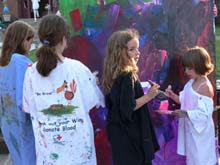 It's winter, and a cold one at that. Across the country we've been seeing all sorts of ice festivals and even an Ice House in Detroit (icehousedetroit.blogspot.com). But in a small town in New York, the unique historic site of Hanford Mills has an ice festival with a twist--and with a purpose.
It's winter, and a cold one at that. Across the country we've been seeing all sorts of ice festivals and even an Ice House in Detroit (icehousedetroit.blogspot.com). But in a small town in New York, the unique historic site of Hanford Mills has an ice festival with a twist--and with a purpose.Back in the 1800s, rural New Yorkers would cut ice from their local lakes and ponds and store them ice houses to use (or sell) in warmer months for refridgeration. Two weeks ago, over 1,100 people showed up at Hanford Mills to continue the tradition. Using a truly frightening-looking ice saw and other tools, the community harvested the ice from the Mill's pond and then transported it to an on-site ice house, where it will be stored
 until the Mills use it to make ice cream on the 4th of July. In addition to the harvest, attendees at the event could enjoy ice-fishing, ice sculpture demonstrations, and a delicious buffet of soups provided by over twenty local restaurants. A giant 2,500-lb ox was on-hand and was a big hit with children, as was a modified Model T snowmobile. Visitors could also enjoy sleigh rides of the Mill grounds, a National Register historic site and one of the few water-powered mills in the country still in operation.
until the Mills use it to make ice cream on the 4th of July. In addition to the harvest, attendees at the event could enjoy ice-fishing, ice sculpture demonstrations, and a delicious buffet of soups provided by over twenty local restaurants. A giant 2,500-lb ox was on-hand and was a big hit with children, as was a modified Model T snowmobile. Visitors could also enjoy sleigh rides of the Mill grounds, a National Register historic site and one of the few water-powered mills in the country still in operation. The harvest has been an annual tradition since the 1980s. This year's attendance has been one of the biggest showings yet, and is quite impressive given the town of East Meredith has a population of about 1,000. The Harvest is an excellent example of preserving community memory in a way that is not only interactive, but fun and brings together the community. Plus, using the ice for future community events provides a thread of continuity that truly echoes the
The harvest has been an annual tradition since the 1980s. This year's attendance has been one of the biggest showings yet, and is quite impressive given the town of East Meredith has a population of about 1,000. The Harvest is an excellent example of preserving community memory in a way that is not only interactive, but fun and brings together the community. Plus, using the ice for future community events provides a thread of continuity that truly echoes thehistoric purpose of the process--in a way that is stil relevant to today. The Executive Director of the Mills, Liz Callahan, says it best in article in The Daily Mail: "We try to connect and celebrate the past and present resources of life in a rural community like ours in tangible and engaging ways for our visitors and the broader community. We have a very rich history and a very unique community. It's important to celebrate this!"
For more information on the Mills, check out their webpage and take a virtual tour at http://www.hanfordmills.org/.



 And finally, this wouldn't be a Community Memory Project post without a dose of art thrown in. Prospect New Orleans is a biennial show of contemporary art held in New Orleans. This is no every-day art event however. The main goal of Prospect is to play a significant role in the revitalization of the city by building an art tourism infrastructure and supporting local artists and entrepreneurs. With installations across the city, some poignant ones highlight the history--and the loss--experienced in the 9th ward. The first biennial was in 2008, with the next schedule for Nov 13, 2010 - Feb 13, 2011.
And finally, this wouldn't be a Community Memory Project post without a dose of art thrown in. Prospect New Orleans is a biennial show of contemporary art held in New Orleans. This is no every-day art event however. The main goal of Prospect is to play a significant role in the revitalization of the city by building an art tourism infrastructure and supporting local artists and entrepreneurs. With installations across the city, some poignant ones highlight the history--and the loss--experienced in the 9th ward. The first biennial was in 2008, with the next schedule for Nov 13, 2010 - Feb 13, 2011.












